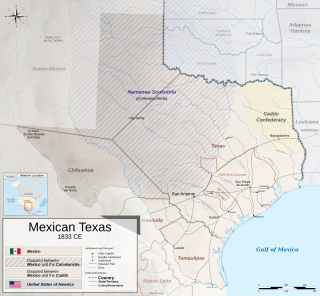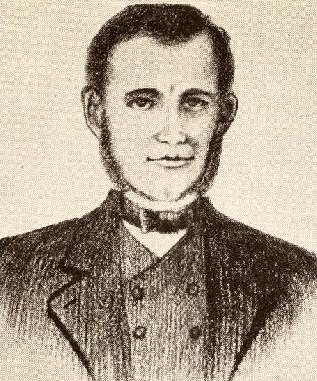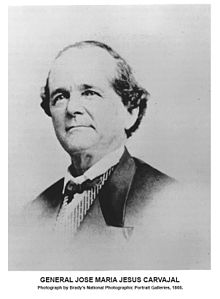
The Texas Revolution was a rebellion of colonists from the United States and Tejanos against the centralist government of Mexico in the Mexican state of Coahuila y Tejas. Although the uprising was part of a larger one, the Mexican Federalist War, that included other provinces opposed to the regime of President Antonio López de Santa Anna, the Mexican government believed the United States had instigated the Texas insurrection with the goal of annexation. The Mexican Congress passed the Tornel Decree, declaring that any foreigners fighting against Mexican troops "will be deemed pirates and dealt with as such, being citizens of no nation presently at war with the Republic and fighting under no recognized flag". Only the province of Texas succeeded in breaking with Mexico, establishing the Republic of Texas. It was eventually annexed by the United States.
Domingo de Ugartechea was a 19th-century Mexican Army officer for the Republic of Mexico.

The Battle of San Jacinto, fought on April 21, 1836, in present-day La Porte and Deer Park, Texas, was the final and decisive battle of the Texas Revolution. Led by General Samuel Houston, the Texan Army engaged and defeated General Antonio López de Santa Anna's Mexican army in a fight that lasted just 18 minutes. A detailed, first-hand account of the battle was written by General Houston from the headquarters of the Texan Army in San Jacinto on April 25, 1836. Numerous secondary analyses and interpretations have followed.

Coahuila y Tejas, officially the Estado Libre y Soberano de Coahuila y Tejas, was one of the constituent states of the newly established United Mexican States under its 1824 Constitution.

Mexican Texas is the historiographical name used to refer to the era of Texan history between 1821 and 1836, when it was part of Mexico. Mexico gained independence in 1821 after winning its war against Spain, which began in 1810. Initially, Mexican Texas operated similarly to Spanish Texas. Ratification of the 1824 Constitution of Mexico created a federal structure, and the province of Tejas was joined with the province of Coahuila to form the state of Coahuila y Tejas.

The Anahuac disturbances were uprisings of settlers in and around Anahuac, Texas, in 1832 and 1835 which helped to precipitate the Texas Revolution. This eventually led to the territory's secession from Mexico and the founding of the Republic of Texas. Anahuac was located on the east side of the Trinity River near the north shore of Galveston Bay, which placed it astride the trade route between Texas and Louisiana and from there to the rest of the United States. In new attempts to curtail smuggling and enforce customs tariffs from the coastal settlements, Mexico placed a garrison there after 1830. American settlers came into conflict with Mexican military officers, rose up against them, and increased political activity and residents of numerous communities declared support for the federalists, who were revolting against the Mexican Government.
In 1832, the Anglo-American settlers were involved in a conflict with Mexican commander John Davis Bradburn near the northern extent of Trinity Bay at Anahuac, Texas. The settlers were opposed to control of their daily affairs by the centralist government. They were primarily at odds with the administration over the subject of tariffs on imports and exports and over the presence of conscripted criminals in the Mexican garrison at Anahuac located at the confluence of the Trinity river and bay four miles south of the Turtle Bayou crossing, whom the colonists blamed for a number of local crimes. The simmering conflict reached a head when Bradburn took in two escaped enslaved people from Louisiana. Though slavery was officially illegal in Mexico, the Mexican authorities wanted to encourage Anglo-American colonization of the frontier and tolerated indentured servants for ten years, among the colonists. Among that population included three previously enslaved people who escaped from Louisiana and were given asylum by Bradburn. Two local lawyers, William B. Travis and Patrick C. Jack, attempted to return the freed people to the American who claimed to own them but were arrested and held in the Anahuac garrison after they had forged a letter to Bradburn threatening armed intervention from Louisiana militia.

The Republic of the Rio Grande was one of a series of independence movements in Mexico against the unitary government dominated by Antonio López de Santa Anna, including the Republic of Texas, and the second Republic of Yucatán. Insurgents fighting against the Centralist Republic of Mexico sought to establish the Republic of the Rio Grande as an independent nation in Northern Mexico. The rebellion lasted from 17 January to 6 November 1840.
The Battle of San Patricio was fought on February 27, 1836, between Texian rebels and the Mexican army, during the Texas Revolution. The battle occurred as a result of the outgrowth of the Texian Matamoros Expedition. The battle marked the start of the Goliad Campaign, the Mexican offensive to retake the Texas Gulf Coast. It took place in and around San Patricio.
The battle of Agua Dulce Creek was a skirmish during the Texas Revolution between Mexican troops and rebellious colonists of the Mexican province of Texas, known as Texians. As part of the Goliad Campaign to retake the Texas Gulf Coast, Mexican troops ambushed a group of Texians on March 2, 1836. The skirmish began approximately 26 miles (42 km) south of San Patricio, in territory belonging to the Mexican state of Tamaulipas.
The Consultation, also known as the Texian Government, served as the provisional government of Mexican Texas from October 1835 to March 1836 during the Texas Revolution. Tensions rose in Texas during early 1835 as throughout Mexico federalists began to oppose the increasingly centralist policies of the government. In the summer, Texians elected delegates to a political convention to be held in Gonzales in mid-October. Weeks before the convention and war began, the Texian Militia took up arms against Mexican soldiers at the Battle of Gonzales. The convention was postponed until November 1 after many of the delegates joined the newly organized volunteer Texian Army to initiate a siege of the Mexican garrison at San Antonio de Bexar. On November 3, a quorum was reached in San Antonio. Within days, the delegates passed a resolution to define why Texians were fighting. They expressed allegiance to the deposed Constitution of 1824 and maintained their right to form the General Council. In the next weeks, the council authorized the creation of a new regular army to be commanded by Sam Houston. As Houston worked to establish an army independent from the existing volunteer army, the council repeatedly interfered in military matters.
Antonio Canales Rosillo was a 19th-century Mexican politician, surveyor, and military officer also known for co-founding the short-lived Republic of the Rio Grande.
Juan Davis Bradburn was a brigadier general in the Mexican Army. His actions as commandant of the garrison at Anahuac in Mexican Texas in 1831 and 1832 led to the events known as the Anahuac Disturbances.
The Matamoros Expedition was a planned 1836 invasion of the Mexican port town of Matamoros by rebellious Texians. As the Mexican government transitioned from federalism to a centralized government in 1835, many federalists offered armed opposition. In Mexican Texas, settlers launched a full rebellion, known as the Texas Revolution, in October. By the end of the year, the Texians had expelled all Mexican soldiers from their territory. Confident that there would be no more fighting within their lands, Texans began looking for ways to extend the fight.
Plácido Benavides (1810–1837) was an early Mexican-born settler in De Leon's Colony, Victoria County, Texas. Benavides earned himself the sobriquet of the Paul Revere of Texas for his 1836 journey from San Patricio to Goliad to Victoria, warning residents of the approaching Mexican army. He was twice elected alcalde of Victoria, Texas. He married into the powerful De León family, and with his wife Agustina became the father of three daughters. Benavides fought against the dictatorship of Antonio López de Santa Anna, but did not feel Texas should be separated from Mexico.
Silvestre De León (1802–1842) was the second son born to the influential De León family in Victoria, Texas. He became the third alcalde of Victoria. De León joined his brother-in-law Plácido Benavides to fight with Stephen F. Austin at the 1835 Siege of Béxar. He joined the rest of the De León family in New Orleans in 1836 after Brigadier General Thomas Jefferson Rusk ordered the evacuation of Mexican families from Victoria. In 1842, he returned to Victoria and was murdered by persons unknown. Texas Historical Marker number 6544 placed at Evergreen Cemetery in 1972 acknowledges Silvestre De León's contribution to Texas.
Fernando De León (1798–1853) was a co-founder of Victoria, Texas, and the first commissioner and colonization manager of De León's Colony. He fought against Antonio López de Santa Anna. De León was an aide-de-camp to provisional Texas governor James W. Robinson. In the war's confusion about Mexican loyalties, De León was first incarcerated by the Mexican army, only to be released and be incarcerated by the Texas army. When his brother Silvestre was murdered, he adopted Silvestre's sons. After the war, he legally recovered 50,000 acres of his land that had been redistributed to Texans. Recorded Texas Historic Landmark number 6541 placed at Evergreen Cemetery in 1972 acknowledges Fernando De León's contribution to Texas.

Martín De León (1765–1833) was a rancher and wealthy Mexican empresario in Texas who was descended from Spanish aristocracy. He was the patriarch of one of the prominent founding families of early Texas. De León and his wife Patricia de la Garza established De León's Colony, the only predominantly Mexican colony in Texas. They founded the town of Villa de Nuestra Señora de Guadalupe Victoria Nombre de Jesús on the Guadalupe River. The name referred both to the river and to Mexico's president Guadalupe Victoria.
Patricia de la Garza De León (1775–1849) was the matriarch of one of the prominent founding families of early Texas. Doña Patricia raised ten children, some of whom helped change the course of history. At age 49, she uprooted her life in 1824 to help her husband Martín De León establish the predominantly Mexican De León's Colony. She contributed her inherited assets to the founding of the colony, and helped establish a school and a church. From the onset, she worked to instill a sense of Mexican and Spanish culture in the colony. After the death of her husband, Doña Patricia assumed the role of head of the family. Recorded Texas Historic Landmark number 6539 placed at Evergreen Cemetery in 1972 acknowledges Patricia de la Garza De León's contribution to Texas. Recorded Texas Historic Landmark number 6543 placed at Church and Bridge Streets in 1936 denotes the home of Patricia de la Garza De León and Don Martin De León's home in Victoria.
Jesús de Cárdenas Duarte was the Governor of Tamaulipas and the President of the Republic of the Rio Grande.







